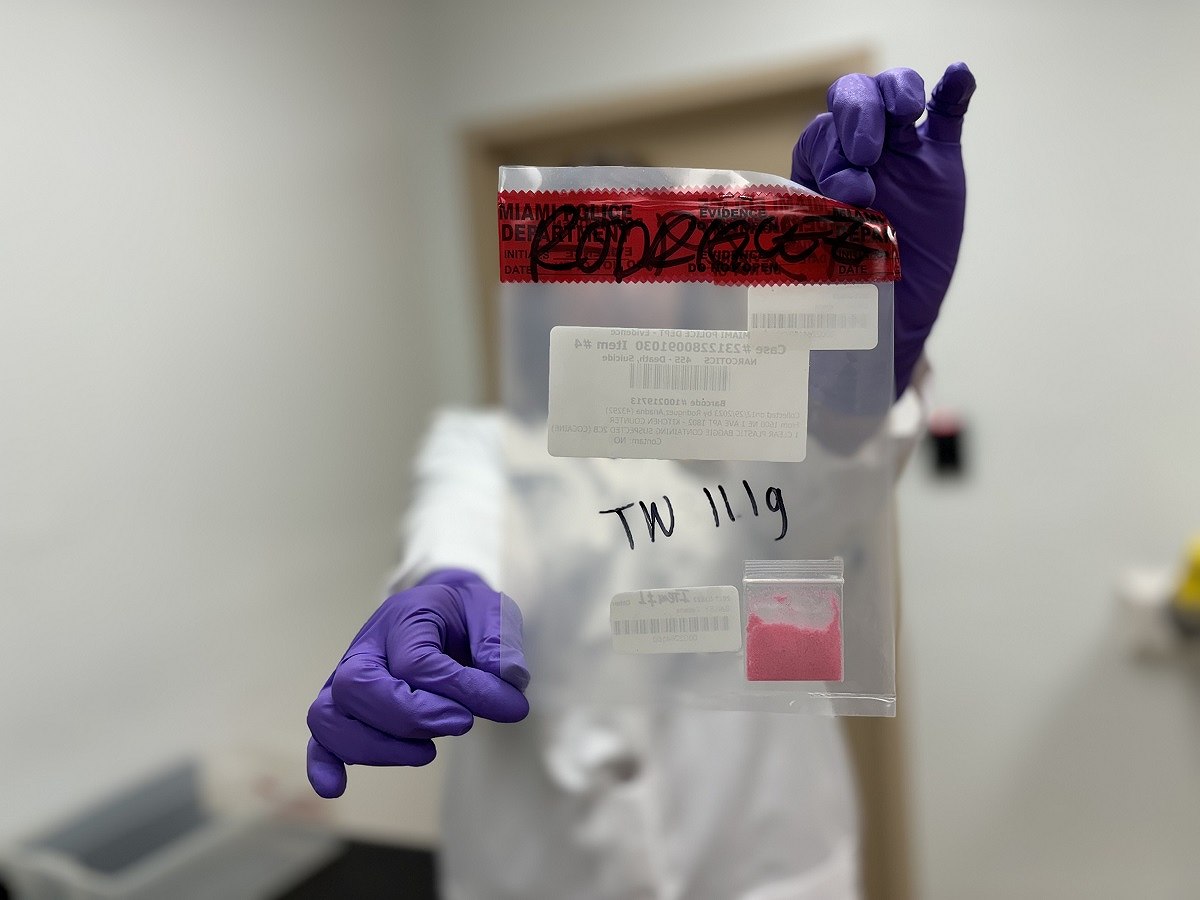
Diane Moore, head of toxicology for the Miami-Dade County Medical Examiner’s Office, holds a sample of suspected tusi.
12:26 JST, October 25, 2024
MIAMI – It’s hot pink, like cotton candy. It even smells sweet. But there is danger lurking in the mind-altering powder known, variously, as pink cocaine or tusi.
The party drug that’s garnering attention because of its alleged connection to music mogul Sean “Diddy” Combs – and the recent death of former One Direction star Liam Payne – typically contains no cocaine. Instead, market-savvy drug dealers concoct the brightly colored powders from a number of substances, often illicit ketamine mixed with ecstasy, law-enforcement officials say.
Traffickers may seek to expand beyond the party scenes in big cities such as New York and Miami. Officials warn that users may not sufficiently appreciate the risks of ingesting unknown substances that include ketamine, a potent anesthetic already surging as a prescription medication and which led to the death of actor Matthew Perry.
In Miami, the risks were underscored in August when a social media model was arrested on allegations that she became so intoxicated on tusi that she killed two people in a hit-and-run car crash. Separately, the Miami-Dade County Medical Examiner’s Office is studying a string of deaths involving ketamine appearing in pink powders, including the case of a man who became so paranoid and agitated that he leaped off a hotel balcony.
“These powders can be very misleading. They’re a nice pink color and often have a nice sweet aroma to them,” said Diane Moore, head of toxicology at the Miami-Dade County Medical Examiner’s Office. “But people don’t really know what they’re using.”
The emergence of tusi in South Florida and New York nightclubs and elsewhere complicates an increasingly unpredictable drug supply in the United States. Fentanyl, the synthetic opioid manufactured in clandestine Mexican labs and smuggled north, remains by far the nation’s most dangerous drug, even as fatal overdoses appear to have declined. Unbeknownst to some users of fentanyl, dealers mix in other synthetic drugs easily purchased online such as potent opioids known as nitazenes or the tranquilizer xylazine.
A senior Drug Enforcement Administration official warned that traffickers are capitalizing on misperceptions that club drugs are safer. Tusi, the official said, is a “kind of kitchen-sink drug.”
“When you look at the lab results, they are throwing everything into this – which is just sort of reflective of where we are in the drug market,” said the official, who spoke on the condition of anonymity to discuss agency intelligence.
Versions of the drug emerged more than a decade ago in Colombia, where drug dealers dubbed it tusi as a phonetic translation of 2C, a class of psychedelics discovered in the late 1970s. Those psychedelics became popular in the U.S. club scene in the 1990s and were sometimes sold as ecstasy, or MDMA.
Today, tusi rarely contains those psychedelic drugs, said Joseph J. Palamar, an epidemiologist at New York University Grossman School of Medicine who studies drug use. Instead, dealers appear to be capitalizing on confusion and growing interest in psychedelics.
“I view it as a marketing scheme by drug dealers,” said Palamar, author of a paper last year in the American Journal of Drug and Alcohol Abuse warning about tusi.
Dealers dye the powders. Depending on the mix of uppers and downers, the effects can be unpredictable, especially if consumed with alcohol, Palamar said.
A New York electronic-music enthusiast in her late 30s who takes tusi when she parties on weekends said the drug enhances the music and lights on the dance floor.
“The energy feels good. It doesn’t last that long, and you’re not hung over the next day,” said the woman, who spoke on the condition of anonymity for fear she could lose her corporate job.
But she worries about consuming from a batch that is too potent or contains an unknown substance. “There are so many varieties,” she said. “People make it different ways.”
The drug has already achieved celebrity infamy.
Multiple media outlets this week reported that Payne, who died after falling from a balcony in Buenos Aires on Oct. 16, had multiple drugs in his system, including “pink cocaine.”
A March lawsuit alleged that Combs arranged for the transport of tusi across state lines. Combs was arrested in September on allegations of sex trafficking that included plying women with ketamine, although a federal indictment does not name tusi. A federal prosecutor told a judge that bags of pink powder were found in Combs’s New York hotel room when he was arrested.
Confusion about the drug emerged in the case of Maecee Marie Lathers, 24, of Miami Gardens, who described herself in social media posts as a model. Early on Aug. 10, police and prosecutors said, she plowed her white Mercedes-Benz into two vehicles crossing an intersection near downtown Miami, resulting in two deaths.
She walked away but was detained by witnesses, according to an arrest report. Officers found her lying on the pavement, bloodied and partially naked, screaming incoherently, according to police reports and body-camera footage. Lathers said she was under the influence “and she was from the future and had a crystal ball,” an arrest report said.
Lathers is charged with driving under the influence manslaughter, among other felonies, and has pleaded not guilty. A police arrest report and prosecutor court filing mistakenly refer to the drug as “2C,” the decades-old psychedelic drug. A toxicology report, released through a public-records request, revealed Lathers had ketamine and MDMA in her blood.
The report revealed the alarming presence of another drug: fentanyl. It was unclear whether the tusi Lathers is suspected of ingesting was laced with fentanyl or if the opioid was consumed separately. Her defense attorney declined to comment.
The test results illustrate the risk that drug dealers might add cheap fentanyl to batches sold as tusi, a possibly lethal combination if users lack opioid tolerance.
“I’ve been warning about this possibility for some time,” Palamar said. “Fentanyl entering the tusi supply could be disastrous.”
Palamar is collaborating with the Center for Forensic Science Research & Education, a nonprofit toxicology organization that runs an early-warning program researching novel drugs, to test the saliva of New York clubgoers to understand what is in the drugs they are using.
Toxicologists at the Miami-Dade County Medical Examiner’s Office have linked brightly colored powders found at death scenes to four suicides and four accidental overdose cases, the latter including famous DJ Erick Morillo, found dead inside his Miami Beach home, and aspiring singer Laura Camila Lozano Sterling, discovered dead inside an upscale Miami Beach hotel.
A ninth death involved a 28-year-old Chicago area man who had been using a pink powder and drinking with friends on a Miami Beach apartment balcony. According to medical examiner reports, he suddenly became paranoid – convinced someone was trying to kill him – and climbed atop the balcony before plummeting more than 50 feet. His death was ruled an accidental fall.
Each of them tested positive for ketamine, and most had MDMA and other drugs in their systems. More deaths may be associated with tusi. Toxicologists have identified about 50 other deaths involving ketamine and MDMA since 2018 but have not seen evidence of pink powders.
Ketamine, a drug commonly used to numb pain during surgeries and which is subject to state and federal restrictions, has been used recreationally for years. Its legal use has proliferated in recent years amid a boom in clinics and telehealth providers specializing in the drug’s potential to deliver rapid relief for people suffering from depression.
The drug prompts feelings of euphoria and sedation but can also act as a stimulant, medical experts say. At higher doses, ketamine’s effects can be severe.
“People who take a large amount of ketamine have problems with paranoia, delusions and hallucinations,” said Robert Freedman, a professor of psychiatry and pharmacology at the University of Colorado School of Medicine who has studied the effects of the drug.
Law enforcement officials worry that cheap ketamine manufactured overseas could fuel the U.S. market for tusi.
In recent years, federal agents at Miami International Airport have regularly arrested suspected smugglers from South America caught with premixed pink tusi hidden in bags or clothing. Sometimes, those couriers disembark from planes “pretty jacked up” on the drug, said Anthony Salisbury, special agent in charge of the Homeland Security Investigations South Florida field office.
“You look at their phone, and they’ve got little pink crystals because they were snorting on the plane,” Salisbury said.
The DEA has warned that the Mexican Sinaloa Cartel – which has flooded the United States with fentanyl – is capable of importing vast amounts of ketamine from China to manufacture tusi. This year, a Coast Guard cutter found tusi among shipments of cocaine in the waters off Mexico and Central and South America.
Salisbury said investigators are concerned that because premixed tusi from South America is expensive – about $100 a gram – domestic traffickers might be making their own batches with cheap ketamine and MDMA purchased from overseas through the mail.
That appears to be happening in New York, according to New York City Special Narcotics Prosecutor Bridget G. Brennan, whose office recorded at least 40 seizures of ketamine or ketamine mixtures – stemming from 24 prosecutions – in 2023 and the first half of 2024. Investigators believe illicit ketamine was used to concoct colorful mixtures also seized in some cases.
“There’s nothing that I’ve seen that would indicate that it’s diverted” from legitimate stocks prescribed by doctors or used by veterinarians, Brennan said. “Most likely, it’s being imported.”
"News Services" POPULAR ARTICLE
-

American Playwright Jeremy O. Harris Arrested in Japan on Alleged Drug Smuggling
-

Japan’s Nikkei Stock Average as JGB Yields, Yen Rise on Rate-Hike Bets
-

Japan’s Nikkei Stock Average Licks Wounds after Selloff Sparked by BOJ Hike Bets (UPDATE 1)
-

Japanese Bond Yields Zoom, Stocks Slide as Rate Hike Looms
-

Japan’s Nikkei Stock Average Buoyed by Stable Yen; SoftBank’s Slide Caps Gains (UPDATE 1)
JN ACCESS RANKING
-

Keidanren Chairman Yoshinobu Tsutsui Visits Kashiwazaki-Kariwa Nuclear Power Plant; Inspects New Emergency Safety System
-

Imports of Rare Earths from China Facing Delays, May Be Caused by Deterioration of Japan-China Relations
-

University of Tokyo Professor Discusses Japanese Economic Security in Interview Ahead of Forum
-

Japan Pulls out of Vietnam Nuclear Project, Complicating Hanoi’s Power Plans
-

Govt Aims to Expand NISA Program Lineup, Abolish Age Restriction























